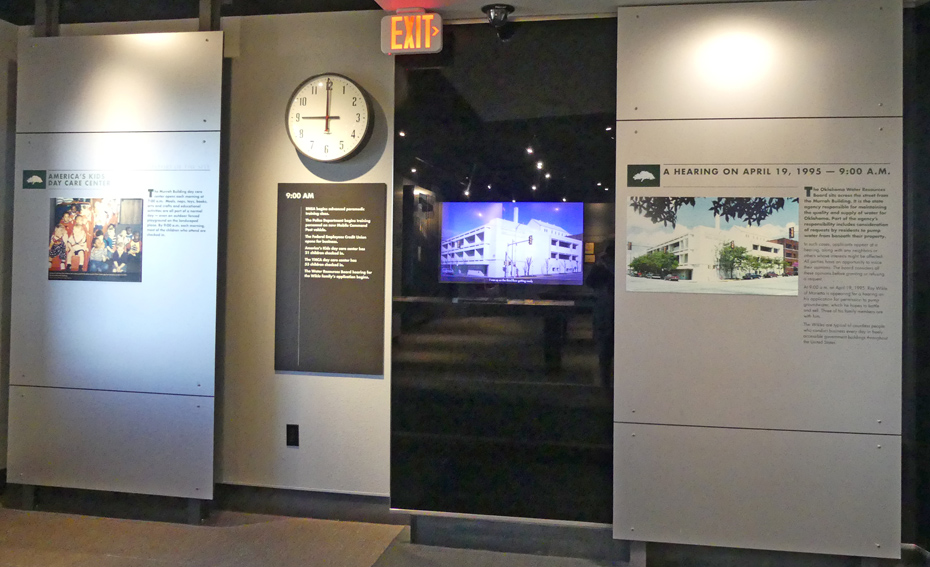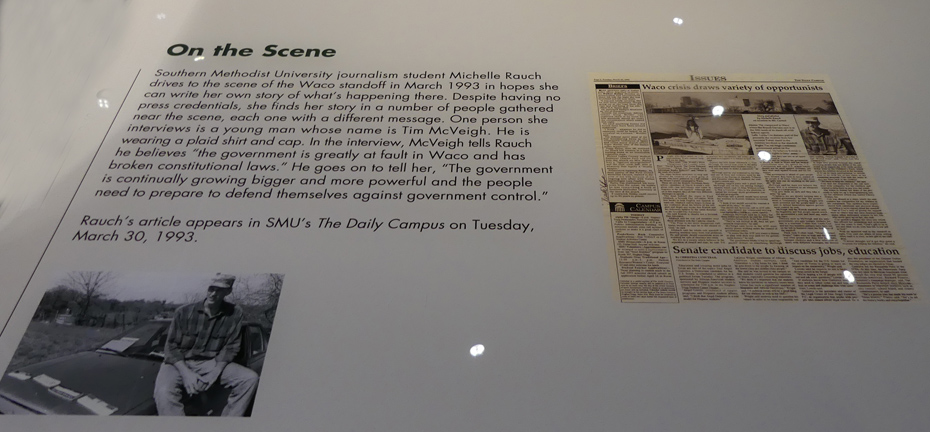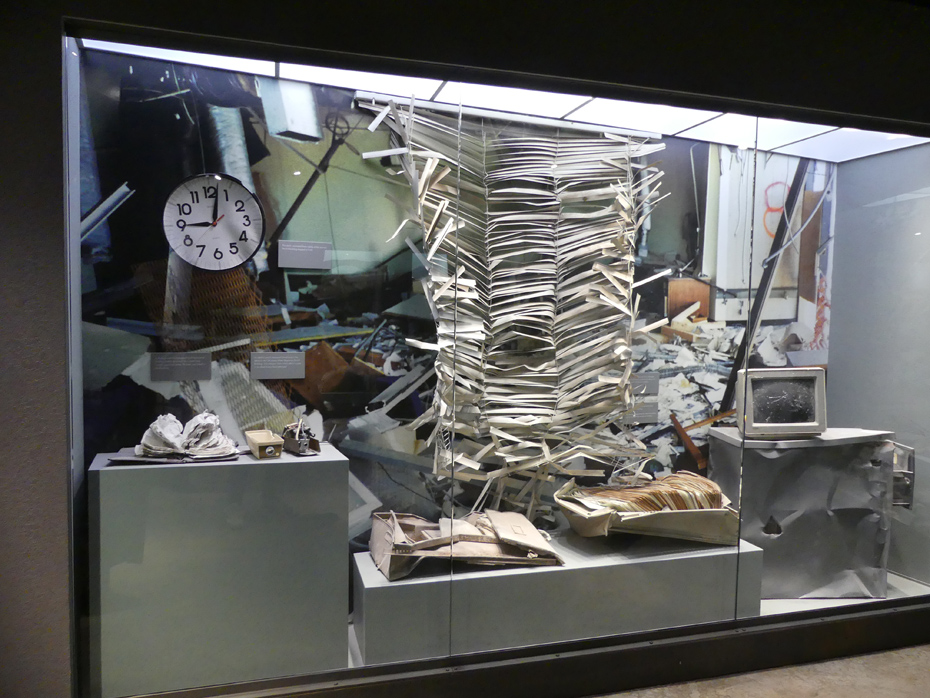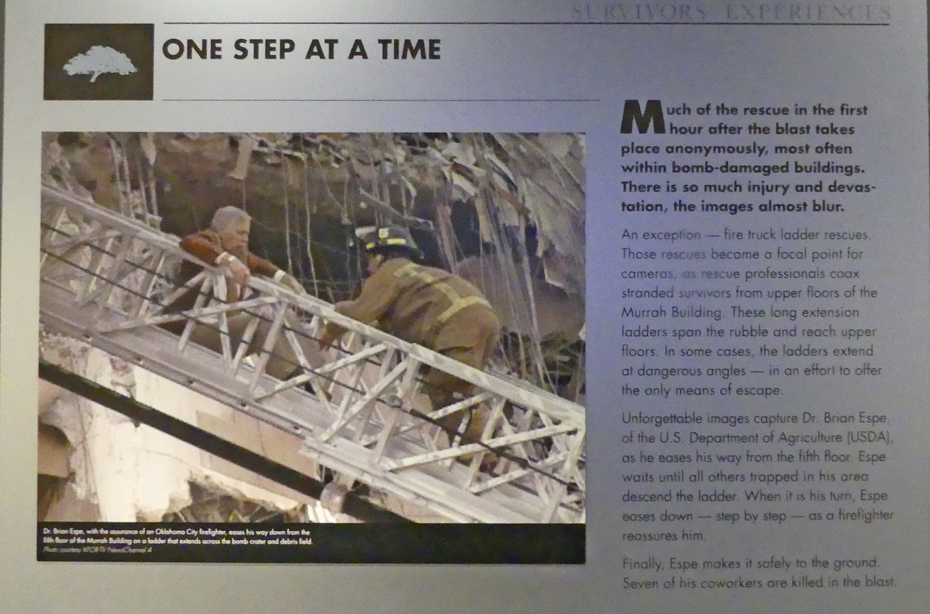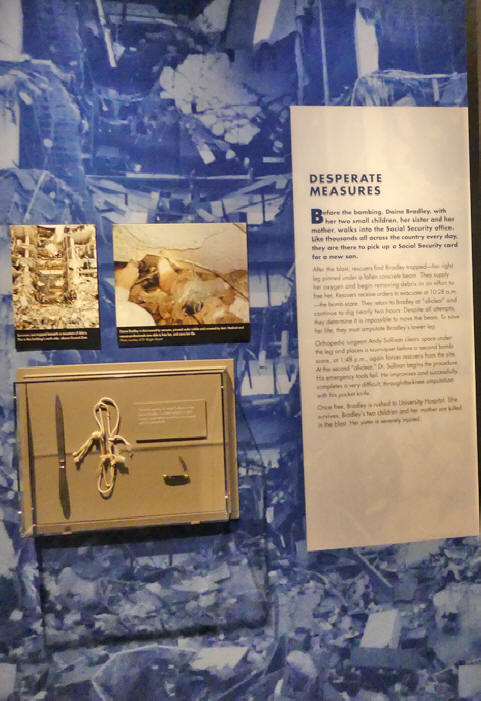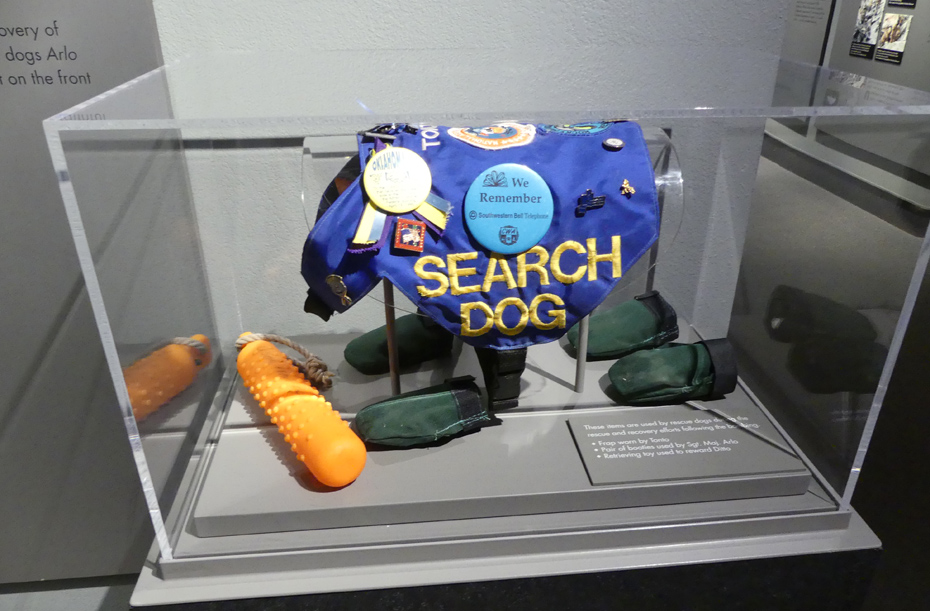
|
|
|
|
|
|
|
|
|
|
Oklahoma City is filled with interesting places to visit. There is one that is not a fun quest but do not pass it by without stopping. The Oklahoma City National Memorial Museum walks you through one of the most horrific acts committed in modern history. It takes you minute by minute through the events on April 19, 1995 when a home-grown terrorist took the lives of 168 innocent people, 19 of whom were children, in the bombing of the Alfred P. Murrah Federal Building. The Memorial Museum is in the former Journal Record Building located on the corner next to where the federal building once stood. The Journal Record for the most part withstood the bombing. Today it retells the story of that day so it will never be forgotten. It's the little things so often overlooked that are most poignant, the crumbled rubble all around, yet a filled coffee pot that remained on a table almost untouched. A briefcase found amid the rubble belonging to a woman is displayed making you wonder what was inside that briefcase that had brought her to the federal building--and her death--that fateful day.
You enter and find yourself at the start of everyday business in Oklahoma City. The Murrah Federal Building is opening for business. Officials have returned from a prayer breakfast where ironically the keynote speech was "Pray for Those in Authority." Everything is boringly normal.
Yet, the museum shows that there were clues. In March of 1993 when the Waco Standoff occurred, a young journalism student from Southern Methodist University, Michelle Rauche, went to Waco. She had no press credentials but got her story by interviewing people at the scene. One person she interviewed was a young man who told her, "The government is afraid of the guns people have because they have to have control of the people at all times. Once you take away the guns, you can do anything to the people. You give them an inch and they take a mile. I believe we are slowly turning into a socialist government. Government is continually growing bigger and more powerful, and the people need to prepare to defend themselves against government control." That young man was Timothy McVeigh. It was no coincidence that the Oklahoma City bombing occurred on the second anniversary of the end of the Waco Standoff. There are artifacts retrieved from the wreckage, photos, informational placards and interactive exhibits that tell the story of an event that should never be forgotten. There are photos of the Federal building and adjoining buildings as they were at 9AM that morning. The YMCA Day Care had 53 kids present; America's Kids Day Care had 21. Emergency Medical Services Authority had begun a class on paramedic training. The Employee Credit Union opened its doors. Just another day. Two minutes later all Hell broke out.
You walk into an exhibit displaying the rubble and destruction. You view artifacts from the explosion, a piece of a street light, crumbled mini-blind from an office window, and a clock stopped at 9:02AM.
One placard shows one of the early rescues. Dr. Brian Espe, was a veterinarian with the U.S. Department of Agriculture. His morning was just beginning in a meeting room on the fifth floor of the Murrah Federal Building when the bomb tore the facility apart. He survived by ducking under a table. He waited until all the others were brought down the fire truck extension ladder and then began a terrifying descent to safety. Espy was frightened of heights. Firefighter Mark Mulman coaxed Espe who sat on the ladder and inched down. Seven of his co-workers were not so lucky. They died in the explosion.
So many of the stories told at the Oklahoma City National Memorial Museum do not have an happy ending. One young mother, Daina Bradley, was coming to the federal building to get a social security card for her new-born son. She was accompanied by her two children, her mother, and sister. The explosion trapped her beneath a huge cement beam. After hours of rescuers working frantically to rescue her but being pulled out by a possible second bomb scare, they decided it was impossible to free her. The only solution was to amputate on site. Dr. Andy Sullivan, an orthopedic surgeon begins the procedure only to have to evacuate once more at 1:48 for yet another bomb scare. After the "All Clear" he returned to finish the operation. His emergency tools failed and he completed the amputation with his pocket knife. Bradley was rushed to the hospital and survived. Her children and mother did not. Her sister survived with a serious injury. The cord used for a tourniquet, surgical knife, and pocket knife are on display.
Throughout the day other rescue groups and individuals joined the firefighters, police, sheriff's department, and other local rescuers but it seems that even nature conspired against the rescuers. By 8:30 that evening, a severe thunderstorm, with wind gusts up to 45 mph, enveloped the city. In spite of all this the last known survivor was removed from the wreckage by 10:30PM. There is a Gallery of Honor with the photos and information about the victims.
An exhibit about the heroic rescue dogs showed that they helped save lives and find bodies amid the rubble. Aleta Biddy's body was one found by rescue dogs, Gunny and Arlo. The grateful family allowed the dogs to be seated at Aleta's funeral.
One portion of the rubble caused by the bombing is preserved behind glass so you see the reality not just exhibits. It's a powerful reminder of the havoc one madman can create.
The museum takes the visitor all the way through the trials of the madmen who perpetrated this tragedy. There's a neon sign from the Dreamland Motel in Kansas where McVeigh planned the bombing. Ironically, by the time the FBI figured out who was responsible for the bombing, they found McVeigh was already in jail. He had made a stupid mistake by not having a valid license plate on his yellow Mercury Marquis. An observant Oklahoma State Trooper had pulled him over, found him carrying a concealed gun, and arrested him just 80 miles out of Oklahoma City less than two hours after the bombing.
Investigations lead to a monster-partner, Terry Nichols. The two monsters had been buddies in the army. A third conspirator, Michael Fortier, worked out a plea deal and agreed to testify in exchange for a lesser penalty. He was sentenced to only 12 years in prison. McVeigh was sentenced to death and executed in 2001. I believe even hardcore anti-death-penalty activists could not reasonably argue he didn't deserve execution. When Nichols went to trial, in both federal and state trials, juries deadlocked on the penalty section. Although there was proof he helped buy the explosives and rent the truck; he didn’t actually set off the bomb. Nichols was sentenced to 161 consecutive life terms without the possibility of parole. One of the placards near the end of the museum is a statement by Judge Steven Taylor who could not impose the death sentence after the jury's deadlock. He said, "I find it ironic that the very government that you profess to hate is the very government that assured you got a fair trial and guaranteed your rights." The spot where the Alfred P. Murrah Federal Building and other buildings destroyed in the blast stood are now the Field of Empty Chairs, Reflecting Pool and Rescuer's Orchard. Oklahoma City National Memorial Museum is a transformative experience. You enter a visitor: you leave a participant. For more info: https://oklahomacitynationalmemorial.org/
We'd love your comments! |
Connect with us on:
American Roads
and | ||||
|
Public Disclosure--
Please Read The FTC has a law requiring web sites to let their readers know if any of the stories are "sponsored" or compensated. We also are to let readers know if any of our links are ads. Most are not. They are just a way to direct you to more information about the article where the link is placed. We also have several ads on our pages. They are clearly marked as ads. I think readers are smart enough to know an ad when they see one but to obey the letter of the law, I am putting this statement here to make sure everyone understands. American Roads and Global Highways may contain affiliate links or ads. Further, as their bios show, most of the feature writers are professional travel writers. As such we are frequently invited on press trips, also called fam trips. On these trips most of our lodging, dining, admissions fees and often plane fare are covered by the city or firm hosting the trip. It is an opportunity to visit places we might not otherwise be able to visit. However, no one tells us what to write about those places. All opinions are 100% those of the author of that feature column. . |
|||||
|
Privacy Policy/ Archives /
Contributors /
Subscribe to
American Roads Books by
Kathleen Walls /
Contact /
Sponsor or Advertise/ American Roads & Global Highways Home Page
|

